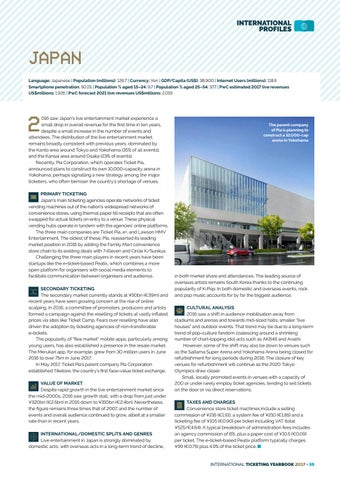INTERNATIONAL PROFILES
JAPAN Language: Japanese | Population (millions): 126.7 | Currency: Yen | GDP/Capita (US$): 38,900 | Internet Users (millions): 118.5 Smartphone penetration: 50.1% | Population % aged 15–24: 9.7 | Population % aged 25–54: 37.7 | PwC estimated 2017 live revenues US$millions: 1,926 | PwC forecast 2021 live revenues US$millions: 2,019
2
016 saw Japan’s live entertainment market experience a small drop in overall revenue for the first time in ten years, despite a small increase in the number of events and attendees. The distribution of the live entertainment market remains broadly consistent with previous years, dominated by the Kanto area around Tokyo and Yokohama (35% of all events), and the Kansai area around Osaka (23% of events). Recently, Pia Corporation, which operates Ticket Pia, announced plans to construct its own 10,000-capacity arena in Yokohama, perhaps signalling a new strategy among the major ticketers, who often bemoan the country’s shortage of venues. PRIMARY TICKETING Japan’s main ticketing agencies operate networks of ticket vending machines out of the nation’s widespread networks of convenience stores, using thermal paper till receipts that are often swapped for actual tickets on entry to a venue. These physical vending hubs operate in tandem with the agencies’ online platforms. The three main companies are Ticket Pia, e+, and Lawson HMV Entertainment. The oldest of these, Pia, reasserted its leading market position in 2016 by adding the Family Mart convenience store chain to its existing deals with 7-Eleven and Circle K/Sunkus. Challenging the three main players in recent years have been startups like the e-ticket-based Peatix, which combines a more open platform for organisers with social media elements to facilitate communication between organisers and audience. SECONDARY TICKETING The secondary market currently stands at ¥50bn (€39m) and recent years have seen growing concern at the rise of online scalping. In 2016, a committee of promoters, producers and artists formed a campaign against the reselling of tickets at vastly inflated prices via sites like Ticket Camp. Fears over reselling have also driven the adoption by ticketing agencies of non-transferable e-tickets. The popularity of “flea market” mobile apps, particularly among young users, has also established a presence in the resale market. The Merukari app, for example, grew from 30 million users in June 2016 to over 75m in June 2017. In May 2017, Ticket Pia’s parent company Pia Corporation established Tiketore, the country’s first face-value ticket exchange. VALUE OF MARKET Despite rapid growth in the live entertainment market since the mid-2000s, 2016 saw growth stall, with a drop from just under ¥320bn (€2.5bn) in 2015 down to ¥310bn (€2.4bn). Nevertheless, the figure remains three times that of 2007, and the number of events and overall audience continued to grow, albeit at a smaller rate than in recent years. INTERNATIONAL/DOMESTIC SPLITS AND GENRES Live entertainment in Japan is strongly dominated by domestic acts, with overseas acts in a long-term trend of decline,
The parent company of Pia is planning to construct a 10,000-cap arena in Yokohama
in both market share and attendances. The leading source of overseas artists remains South Korea thanks to the continuing popularity of K-Pop. In both domestic and overseas events, rock and pop music accounts for by far the biggest audience. CULTURAL ANALYSIS 2016 saw a shift in audience mobilisation away from stadiums and arenas and towards mid-sized halls, smaller “live houses” and outdoor events. That trend may be due to a long-term trend of pop-culture fandom coalescing around a shrinking number of chart-topping idol acts such as AKB48 and Arashi. However, some of the shift may also be down to venues such as the Saitama Super Arena and Yokohama Arena being closed for refurbishment for long periods during 2016. The closure of key venues for refurbishment will continue as the 2020 Tokyo Olympics draw closer. Small, locally promoted events in venues with a capacity of 200 or under rarely employ ticket agencies, tending to sell tickets on the door or via direct reservations. TAXES AND CHARGES Convenience store ticket machines include a selling commission of ¥216 (€1.91), a system fee of ¥210 (€1.85) and a ticketing fee of ¥105 (€0.90) per ticket including VAT (total ¥525/€4.64). A typical breakdown of administration fees includes an agency commission of 8%, plus a paper cost of ¥10.5 (€0.09) per ticket. The e-ticket-based Peatix platform typically charges ¥99 (€0.75) plus 4.9% of the ticket price.
INTERNATIONAL TICKETING YEARBOOK 2017 • 59
